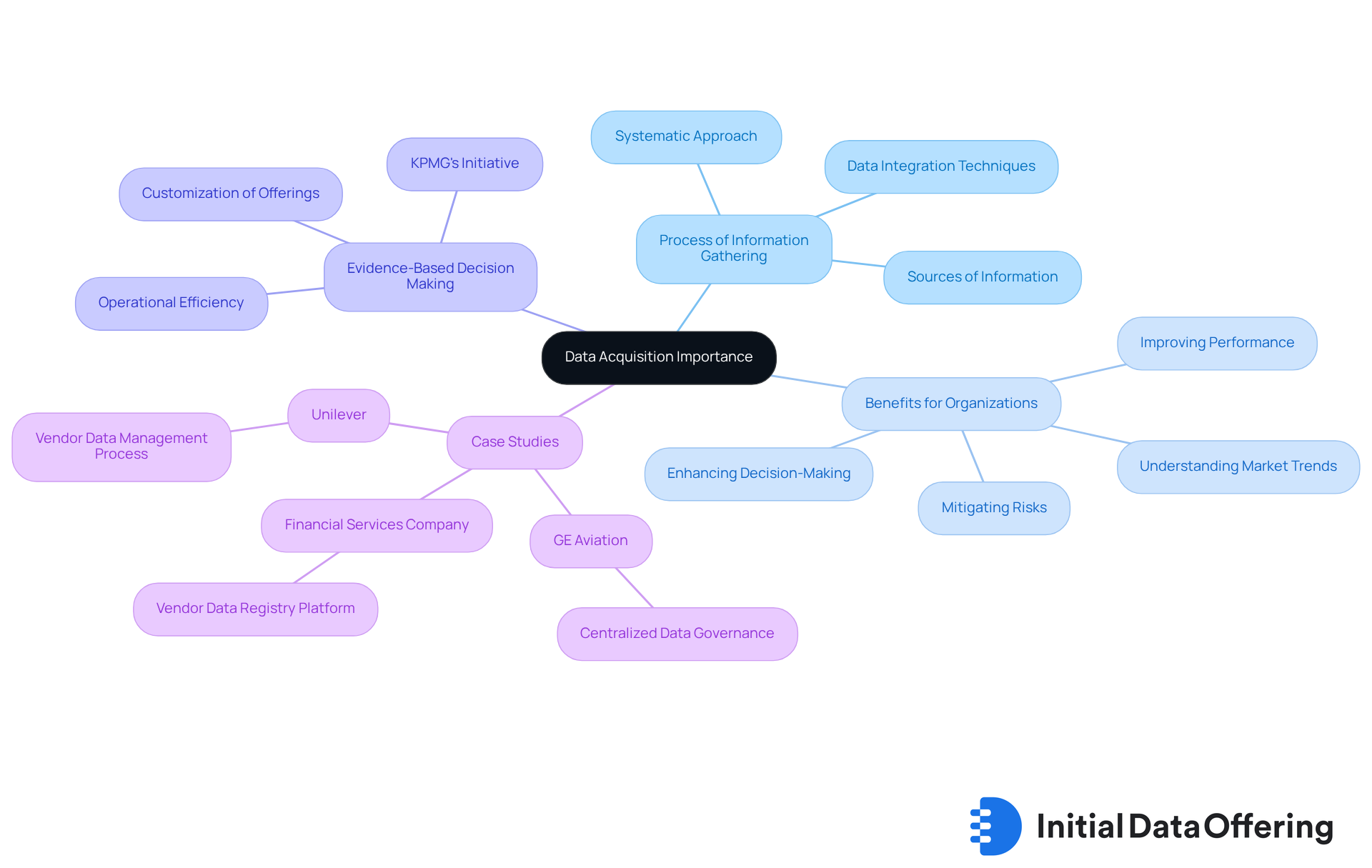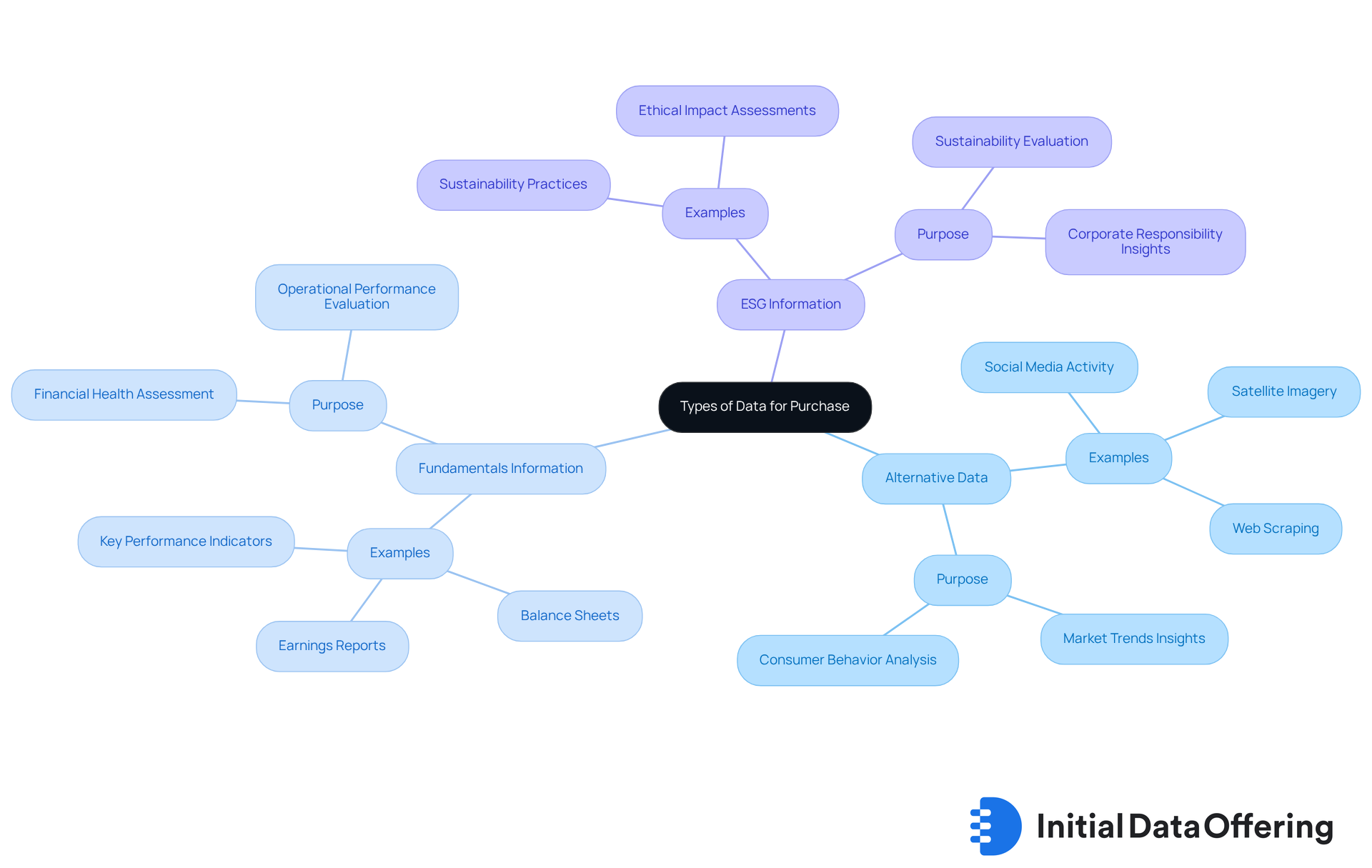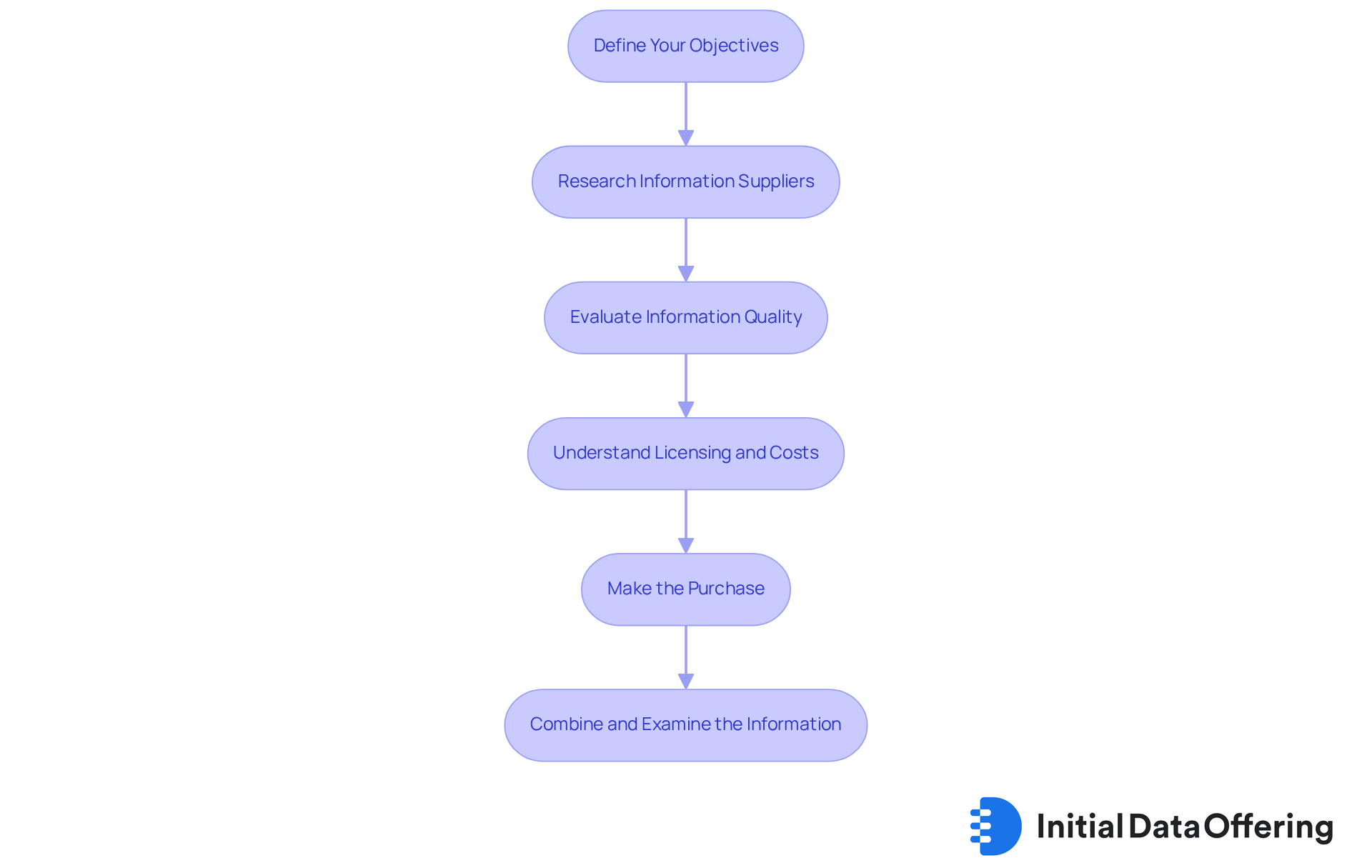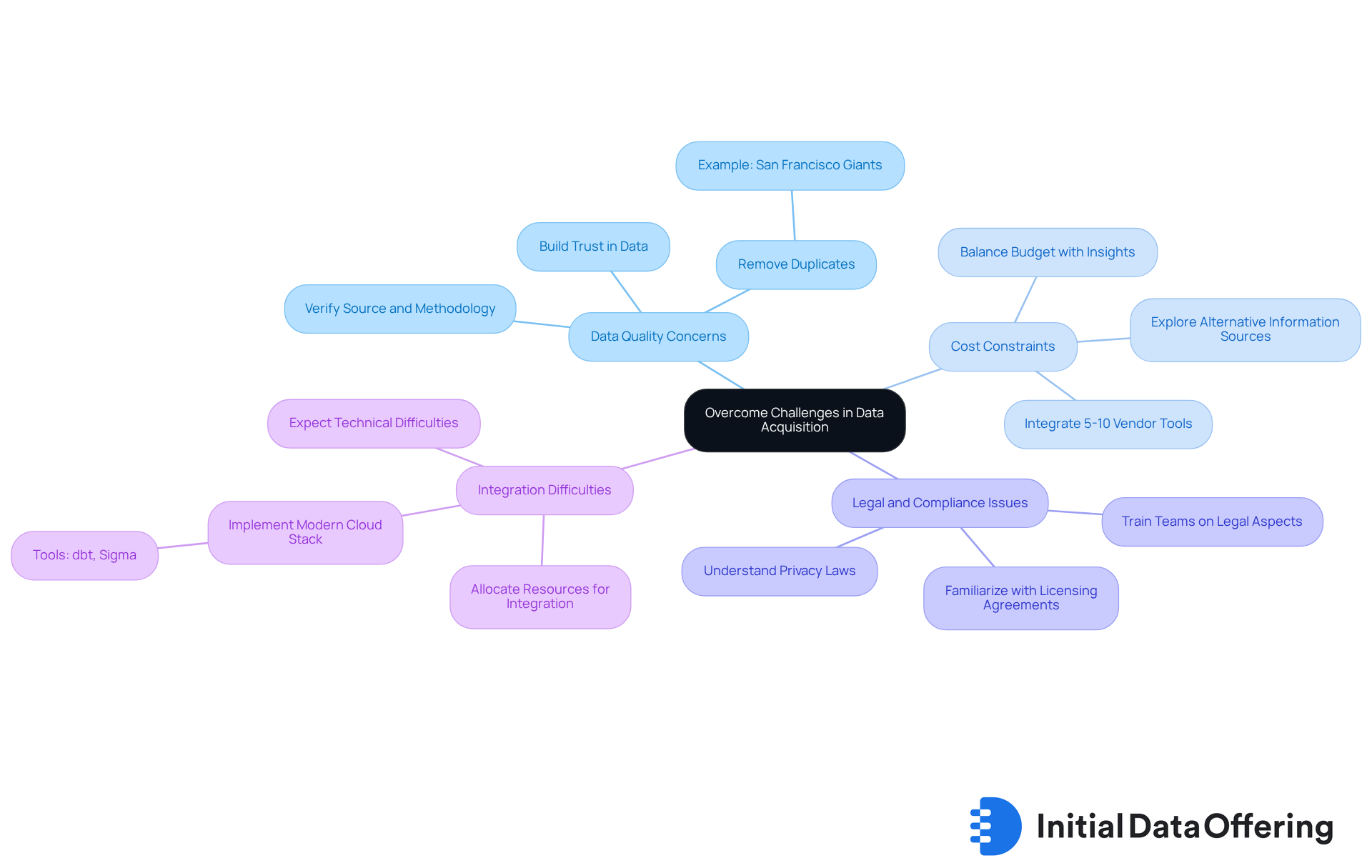Buying Data: Essential Steps and Strategies for Success

Buying Data: Essential Steps and Strategies for Success
Overview
The article outlines essential steps and strategies for successfully acquiring data, emphasizing the importance of:
- Defining objectives
- Researching suppliers
- Evaluating data quality
These features are crucial as they enable organizations to make informed decisions. By effectively researching suppliers, organizations can identify the most suitable sources of data. Evaluating data quality ensures that the information gathered is reliable and relevant, which is vital for effective decision-making.
The advantages of implementing these strategies include overcoming challenges such as data quality concerns and cost constraints. Organizations that prioritize these steps are better positioned to enhance their performance in a competitive landscape. Ultimately, these strategies not only mitigate risks but also empower organizations to leverage data effectively, leading to improved outcomes.
In considering how these strategies can apply to your work, reflect on the specific objectives of your data acquisition efforts. How can defining clear goals streamline your research process? What criteria will you use to evaluate potential suppliers? By addressing these questions, you can ensure that your approach to data acquisition is both strategic and effective.
Introduction
In a world increasingly driven by data, the ability to acquire and leverage information effectively can significantly impact a business's success. Organizations that master the art of data acquisition unlock critical insights that inform strategic decisions, enhance customer satisfaction, and ultimately drive growth.
However, navigating the complexities of purchasing data presents its own set of challenges. These include:
- Ensuring quality and compliance
- Managing costs
What strategies can businesses employ to transform data acquisition into a powerful tool for success? By addressing these challenges, organizations can position themselves to thrive in a data-centric landscape.
Understand the Importance of Data Acquisition
Information acquisition is a systematic process that involves gathering and obtaining information from various sources to inform business decisions and strategies. In today's data-driven world, the ability to access and analyze relevant datasets is essential for understanding market trends, consumer behavior, and competitive landscapes. For instance, a financial services firm developed a vendor information registry platform that unifies inventory, enhancing information governance and reporting functions through cloud-based integrations. By obtaining the right information, organizations can identify opportunities, mitigate risks, and enhance their overall performance.
Furthermore, efficient information gathering aids evidence-based decision-making. This capability enables companies to customize their offerings effectively to satisfy customer requirements. As highlighted by KPMG LLP, their centralized Master Information Management initiative aimed to improve information reliability and simplify reporting. This underscores the importance of information gathering in achieving operational efficiency.
Acknowledging the significance of information gathering, along with strong information management, is crucial for harnessing its potential to attain success across multiple sectors. Are you leveraging the right information to drive your business forward? By understanding and implementing effective information acquisition strategies, organizations can position themselves for success in an increasingly competitive landscape.

Explore Different Types of Data for Purchase
When evaluating information acquisition, it is essential to understand the various categories of buying data that are available for purchase. Common categories include:
- Alternative Data: These are non-traditional data sources that provide insights into market trends and consumer behavior. Examples include social media activity, satellite imagery, and web scraping.
- Fundamentals Information: This encompasses essential financial and operational details about companies, such as earnings reports, balance sheets, and key performance indicators.
- ESG Information: This refers to Environmental, Social, and Governance information that evaluates a company's sustainability practices and ethical impact.
Each category serves distinct purposes and can be leveraged to gain insights into specific market segments or trends. By exploring these categories, businesses can identify which data collections are most relevant for buying data to best support their objectives and enhance decision-making processes. Furthermore, the Initial Information Offering acts as a center for high-quality datasets, showcasing AI-driven features that enhance insights. Enrolling in the Initial Information Offering grants market research analysts exclusive access to distinctive collections, ensuring they remain at the forefront of their information-driven strategies.

Navigate the Data Buying Process: Steps and Considerations
Navigating the buying data process involves several critical steps to ensure successful acquisition.
-
Define Your Objectives: Clearly outline your goals for information acquisition. This foundational step will guide your search and help you identify the most relevant datasets tailored to your needs, ultimately enhancing your decision-making process.
-
Research Information Suppliers: Explore different platforms and providers, such as IDO, to locate trustworthy sources that supply the specific information types you need. Grasping the environment of information providers is crucial; not all databases are created equal. As Mindaugas Jancis notes, "Not all lead databases are the same." Some are superior to others, and knowing how to select the right one is key to your success.
-
Evaluate Information Quality: Assess the quality of potential datasets by reviewing sample information, understanding the methodology behind collection, and identifying any biases. Industry experts emphasize that the quality of information is paramount; unprocessed information alone lacks meaning without proper context and analysis. Dr. Jennifer Priestley stresses that effective analysts must connect technical abilities with business acumen, underscoring the significance of comprehending the context in which information is utilized.
-
Understand Licensing and Costs: Familiarize yourself with the licensing agreements and pricing structures associated with the datasets. This understanding guarantees that the information fits within your budget and aligns with your strategic objectives, ultimately facilitating a more informed purchasing decision.
-
Make the Purchase: Once you have selected a dataset, meticulously follow the provider's purchasing process, retaining all necessary documentation for future reference. This step is essential for preserving transparency and accountability in your information acquisition, ensuring that you can track your investments effectively.
-
Combine and Examine the Information: After obtaining the information, integrate it into your existing systems and conduct comprehensive analyses to derive actionable insights. Efficient information integration is crucial for utilizing the full potential of the obtained datasets, leading to more informed strategies.
By following these steps, users can manage the buying data process with confidence, making informed choices that align with their strategic objectives. In fact, studies suggest that organizations with well-defined information gathering strategies experience higher success rates in achieving their objectives. However, it is important to note that only 20% of analytics insights will deliver business outcomes, underscoring the necessity of a strategic approach to information gathering.

Overcome Challenges in Data Acquisition
Data acquisition presents several challenges that users must navigate effectively.
-
Data Quality Concerns: Ensuring the accuracy and reliability of datasets is paramount. Users should rigorously verify the source and methodology behind the information to avoid pitfalls associated with poor quality, which can undermine trust and lead to ineffective decision-making. For example, organizations such as the San Francisco Giants effectively addressed quality concerns by removing duplicates from their fan engagement information. This led to a more dependable dataset that improved their marketing initiatives. How can your organization ensure data quality in its acquisition processes?
-
Cost Constraints: High-quality datasets often come with a hefty price tag. Balancing budget limitations with the need for valuable insights is crucial. Numerous organizations discover that investing in alternative information sources can yield substantial returns. Statistics indicate that contemporary cloud information solutions typically involve integrating 5-10 vendor tools, which can increase expenses. Therefore, exploring various information options while managing expenses is essential for maximizing value. What strategies can be employed to optimize data acquisition costs?
-
Legal and Compliance Issues: Understanding the legal implications of information usage is critical. Users must familiarize themselves with information privacy laws and licensing agreements to avoid potential legal pitfalls. This knowledge is essential for ensuring compliance and safeguarding organizational interests in information transactions. Are your teams adequately trained on the legal aspects of data usage?
-
Integration Difficulties: Integrating new datasets into existing systems can be complex and resource-intensive. Users should expect technical difficulties and allocate adequate resources for information integration and analysis. Implementing a modern cloud information stack with tools like dbt or Sigma can streamline this process, enabling organizations to leverage their insights more effectively. How can technology facilitate smoother data integration in your organization?
By proactively addressing these challenges, users can enhance their strategies for buying data. This ensures they derive maximum value from buying data while fostering a data-driven culture within their organizations.

Conclusion
In the realm of business, the significance of data acquisition cannot be overstated. The ability to gather and analyze relevant information is vital for making informed decisions that drive success and foster growth. Organizations that effectively leverage data can uncover opportunities, mitigate risks, and enhance their overall performance, positioning themselves favorably in competitive markets.
Throughout the discussion, several key aspects of the data buying process were highlighted. Understanding the types of data available for purchase—ranging from alternative data to ESG information—enables businesses to identify the most pertinent datasets for their objectives. Moreover, navigating the acquisition process involves:
- Defining goals
- Researching suppliers
- Evaluating data quality
- Overcoming challenges related to cost and integration
Each step is crucial in ensuring that organizations not only acquire the right information but also utilize it effectively to inform their strategies.
Ultimately, the importance of a strategic approach to data acquisition is clear. As businesses continue to grapple with the complexities of the data landscape, embracing effective information-gathering strategies will be essential for driving informed decision-making and achieving desired outcomes. Organizations must take proactive steps to address challenges, optimize costs, and ensure compliance, thereby fostering a culture that values data-driven insights. The journey of data acquisition is not merely about buying information; it is about harnessing its potential to fuel innovation and growth in an ever-evolving business environment.
Frequently Asked Questions
What is data acquisition?
Data acquisition is a systematic process of gathering and obtaining information from various sources to inform business decisions and strategies.
Why is data acquisition important in today's world?
In today's data-driven world, accessing and analyzing relevant datasets is essential for understanding market trends, consumer behavior, and competitive landscapes.
How can effective data acquisition impact a business?
Effective data acquisition allows organizations to identify opportunities, mitigate risks, enhance performance, and customize offerings to meet customer requirements.
Can you provide an example of data acquisition in practice?
A financial services firm developed a vendor information registry platform that unifies inventory, enhancing information governance and reporting functions through cloud-based integrations.
How does information gathering support decision-making?
Efficient information gathering aids evidence-based decision-making, enabling companies to make informed choices that drive operational efficiency.
What is the significance of strong information management?
Strong information management is crucial for harnessing the potential of information gathering, which can lead to success across multiple sectors.
What should organizations consider to drive their business forward?
Organizations should leverage the right information and implement effective information acquisition strategies to position themselves for success in a competitive landscape.